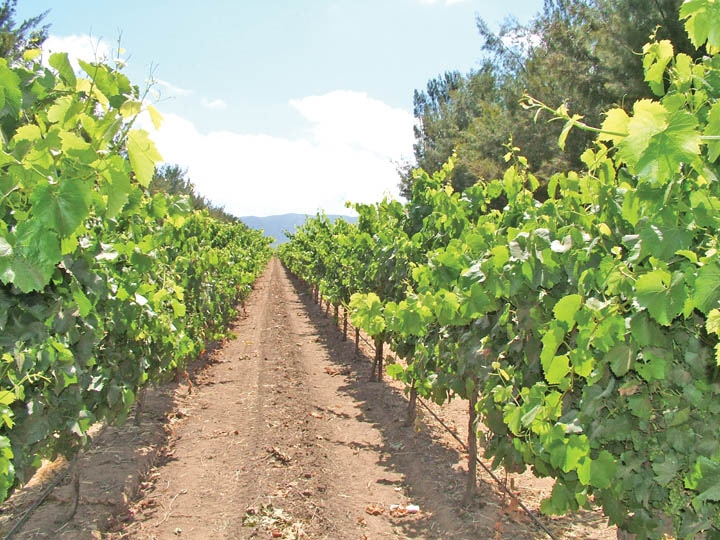April 4, 2011

California’s total grape acreage has fallen to its lowest level in 13 years, and that is good news for surviving grape growers.
According to the California field office of the USDA’s National Agricultural Statistics Service (NASS), there were a total of 842,000 acres of all grapes standing in the state; 50,000 were non-bearing.
That is the lowest non-bearing acreage since 1993.
The 2010 acreage represents a loss of 113,000 acres of grapevines compared to the 955,000 acres standing in 2000. That included 128,000 non-bearing that year.
Low grape prices, especially for raisin and wine grapes, are responsible for this decline. A huge crop in the middle of a downturn is another factor. Wine grape market uncertainty, as well as more attractive crops like almonds, pistachios, pomegranates and others horticultural crops have taken a big roll on California grape acreage. More than 100,000 acres of vines have been bulldozed in the San Joaquin Valley over the past decade and replaced by other crops. Most of that was Thompson seedless.
The wine-type grape acreage for 2010 is estimated at 535,000 acres by NASS. Of the total acres, 497,000 were bearing and 38,000 were non-bearing. Table grape acreage totaled 94,000 acres with 9,000 non-bearing. Acreage of raisin-type grapes totaled 213,000 acres, of which 210,000 were bearing and 3,000 were non-bearing.
The leading wine-type varieties continued to be Chardonnay and Cabernet Sauvignon. Flame Seedless was the leading table-type grape variety.
Thompson Seedless continued to be the leading raisin-type variety and was utilized for raisins, fresh market, concentrate, and wine.
The viticultural bloodbath may be over, at least for one season, as supplies seem to be in balance with winery demand. Raisin grape production finally reached equilibrium with demand last year, when for the first time in decades growers received 100 percent of an established field price at harvest. For many years, growers received only a percentage of the field price and the rest went into a surplus pool to be sold at discounted prices.
For wine grapes, prices have been largely less than the cost of production for several years. One reason is the importation of wine in bulk and bottle. That continues with one out of every three bottles of wine sold in the U.S. from foreign grown grapes. Many of these wines are imported by California wineries either as bottled products or bulk which is blended with California wine. Much of this bulk has come into the U.S. from countries with an oversupply. Two years ago so much Chardonnay was imported, it hung over the domestic Chardonnay market for at least two years and some say three seasons. Wineries are opting to buy cheap bulk wine overseas rather than buy it from California growers.
The U.S. recession since 2008 also has had a dramatic impact on wine sales, particularly premium wines. Restaurant wine sales plummeted. Wine drinkers gravitated to lower priced wines with fewer dollars available. As the economy turns around, these value wines continue to be popular since consumers have discovered they can buy good quality wine at bargain prices. Premium wine sales are coming back, but are still lagging behind the value priced wines.
Aggressive buying from wineries
The decline in inventories and increasing overall wine sales are translating to aggressive buying from wineries for 2010 wine grapes, especially for San Joaquin Valley wine grapes, according to Nat DiBuduo, president of Allied Grape Growers, the state’s largest wine grape marketing cooperative.
“Wineries are very active … much more active in March than the last 10 years,” DiBuduo said. There are reports of winery contracts being offered to plant new vineyards. However, it remains to be seen how many growers, burned by years of market malaise, will respond to offers.
“From Lodi south, demand is better for wine grapes, especially for red wine grapes,” he said. Prices are better than last year.
The premium wine grape area of the North Coast is only attracting “tire kickers” but no price offerings, he said. However, there are more inquiries now from wineries for wine grapes from Mendocino and Lake counties than there were for grapes from the same area at harvest time last year.
DiBuduo did not have details on the Central Coast market, but there are reports of stronger demand there. However, the president of Allied said the Central Valley will recover economically faster than the coastal wine grape producing areas.
“I am bullish about wine grape prices this year after being down for so many years. We should be having a good year,” he said.
A huge 2010 crop could derail DiBuduo’s optimism. “We had a large crop last year, yet so far we are still seeing interest from wineries for grapes this year,” he added.
Growers in some areas are expecting a smaller crop in 2010 because weather conditions last year during fruit bud differentiation for 2010 fruiting buds were not ideal.
However, it is “still too early — we are barely at bud break” this season to make a firm prediction about less fruitful vines this year, said DiBuduo.
DiBuduo bemoaned the fact that continued pressure from imports could take the shine off the 2010 crop. According to the Gomberg-Fredrikson Report, bulk imports are down, but there are more bottled imports coming into the U.S, often imported by California wineries.
“You have to be aware of the total global market — not just bulk wine but bottled wine as well — to understand this local California market,” he added.
“The signs are for a good year. I just hope there is no rain on our parade. Right now at least there is a little more light coming out of the end of the tunnel,” he added.
About the Author(s)
You May Also Like






